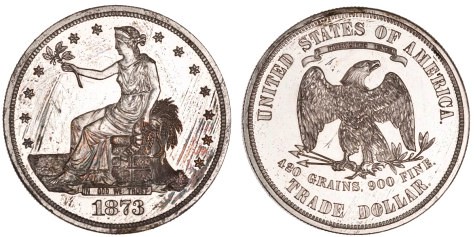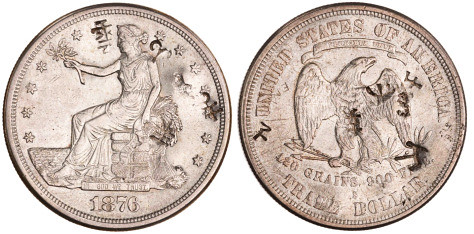
PREV ARTICLE
NEXT ARTICLE
FULL ISSUE
PREV FULL ISSUE
HISTORY OF THE U.S. TRADE DOLLAR
Matthew Wittman of the American Numismatic Society published an article nicely summarizing the history of the U.S. Trade Dollar in his
September 25, 2015 Pocket Change blog entry. -Editor

This week at the International Numismatic Congress in Taormina, I gave a presentation about the US Trade Dollar, a silver coin that was minted between 1873 and 1878 expressly to facilitate trade with East Asia. Its purpose was rather transparently expressed in the coin’s design, which features the figure of liberty seated upon a bounty of trade goods facing west to the ocean with an olive branch in hand. The reverse clearly delimits the national origin of the trade dollar in legend and symbolism, but more interestingly includes a precise description of its silver content: 420 GRAINS, 900 FINE. Quick math shows that it contained 378 grains of pure silver, which was more than the 371 ¼ grains of the ‘standard’ Seated Liberty dollar. This change was made to give the US trade dollar more appeal in the Chinese market, where Spanish dollars minted in the Americas and, after independence in 1821, Mexican dollars were the primary circulating medium. These had a silver content measuring between 374 and 377 grains, which meant that the new US trade dollar had a more silver and bullion value. What the new US trade dollar lacked of course was both recognition and trust. Spanish dollars had been circulating through Asia in volume since the 17th century, and the shroffs who weighed and assayed foreign silver for Chinese merchant house were rightly skeptical of new coins. Still, by 1876 some 12 million US trade dollars had been exported, and the large number of extant ‘chopmarked’ coins, which were struck with punches bearing Chinese characters that indicated their acceptance by merchants, attested to their successful introduction internationally. 
The fatal flaw that doomed the US trade dollar was not its ability to circulate abroad, but an unfortunate provision inserted into the Coinage Act of 1873 that allowed the trade dollars, which were intended for export, to circulate domestically as “legal tender at their nominal value for any amount not exceeding $5 in payment (Sec. 15).” Exactly how this stipulation was worked into the legislation has been much debated, but the practical effect was that when the price of silver declined, it became profitable for bullion dealers to have their silver coined into trade dollars. The new dollars were not exported, but passed domestically at their face value or at a nominal discount. When the coinage law was passed in 1873, the 378 grains of silver in the coin was worth $1.05 in gold, but by 1876 it had declined to .83¢. With the bullion value less than the stated or legal tender value that was the medium of exchange, trade dollars flooded into domestic circulation. In response, the coin was actually demonetized by an act of Congress in July 1876. Despite the fact that it was now demonetized, the trade dollar continued to circulate domestically, alongside a restored ‘standard’ or Morgan dollar that was authorized by the Bland-Allison Act of 1878. At this point, the United States thus had two silver dollars in circulation, one with 371 ¼ of silver and a Liberty Head on its obverse that was legal tender, and the Seated Liberty trade dollar with 378 grains of silver that was not. The mints continued to manufacture trade dollars only with the assurance that the coins would be exported abroad, but controls were so lax, and the potential profits so easy, that many of the 20 million coins minted after it was demonetized made their way into domestic circulation anyways. The coinage of the trade dollar was finally discontinued in 1878, but the damage was done. Because it was not legal tender the trade dollar was in effect simply bullion and it circulated at a severe discount. It was not able to deposited at banks, nor was it accepted by many merchants. The problem was that many unscrupulous businesses continued to pay them out to unwary or unsophisticated employees and customers at face value, which the receiver was never able to get when they tried to spend them. The article also has the lyrics to a contemporary song about the discounted value of the Trade dollar. Check it out! To read the complete article, see:

Wayne Homren, Editor The Numismatic Bibliomania Society is a non-profit organization promoting numismatic literature. See our web site at coinbooks.org. To submit items for publication in The E-Sylum, write to the Editor at this address: whomren@gmail.com To subscribe go to: https://my.binhost.com/lists/listinfo/esylum All Rights Reserved. NBS Home Page Contact the NBS webmaster 
|